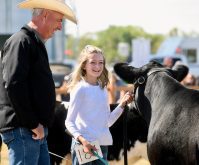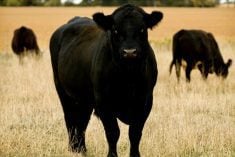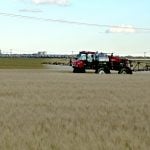It takes longer and costs more to produce grass-finished beef, but Jim Lintott’s customers are willing to pay the asking price.
The key is quality, which he describes as job No. 1.
“I’ve almost never had a consumer tell me, Jim, your rib-eye steak at $17.99 a pound — twice what it’s worth at Safeway — is too bloody expensive and I won’t eat it,” said Lintott, president of the 10-member Manitoba Grass-Fed Beef Association.
At his farmers’ market table, retail customers regularly come to him with a fistful of $100 bills and buy a pile of premium cuts to impress their guests at an upcoming weekend feast.
Read Also

The Canadian Cattle Association’s international advocacy efforts
Global ag policies affect Canadian food policy, so the Canadian Cattle Association participates in international and domestic forums
“That’s the market that’s there. Build that market with a high-quality product and give them bragging rights. Do not sell them a rib-eye steak for $11 a pound. It’s worth $20,” said Lintott, in a presentation at Ag Days hosted by the Manitoba Organic Alliance.
Wayne McDonald, who runs McDonald Farm near Cartwright, direct markets all of the grass-only production from his Galloway-Angus-cross herd of 80 head through an e-commerce-enabled website that also offers pasture pork and lamb.
“The beef is by far the easiest one to sell in terms of customer demand,” said McDonald.
Inspected
His cows are small framed, and carcass weights at 18-24 months average around 450-500 pounds. A provincially inspected abattoir is just 20 minutes away from the farm in Killarney.
The website, which uses a software program called Joomla that is available for free downloading online, is key to his marketing strategy, because it means his store is open 24-7 for customers.
Instead of hiring a webmaster, he is able to update pictures, prices and do inventory tracking himself because the software is very user friendly.
It features pictures and stories explaining how the animals are raised, as well as the farm’s philosophy.
Shoppers can browse through all the product line, then enter their choices in an online shopping cart, and then place an order and pay for it via credit card or PayPal.
“As I was sitting here, I had three orders come in. The online shopping cart is fantastic and it works really well for us,” said McDonald.
Once the order amounts for customers in Winnipeg, Portage or Brandon exceed $3,500 to $6,000, he loads the truck and delivers the frozen meat to a pre-arranged meeting place for customer pickup in a cooler-equipped trailer.
“I’m usually done and gone in half an hour,” said McDonald, who added almost all of his customers are families, and about half of them prepay online.
Different is better
Ian Grossart, who raises 90 head of forage-finished beef on his certified organic farm near Brandon, mainly sells locally from the farm gate.
In the 1990s, faced with the option of “getting big, or getting out,” he decided to switch to organic to boost his profit margins.
“Getting better, and getting different, appealed to me more,” said Grossart. “We’ve gone from using Roundup, Ralgro and Rumensin to aloe vera, kelp and compost.”
Having cattle on his organic farm means he can speed up the nutrient cycling process and turn a profit on a green manure crop by grazing it.
Raising beef the old-fashioned way has bolstered his conviction that he’s doing the right thing by raising healthier food, and he sees the results in positive feedback from his customers.
USDA literature from 1959, he said, states that a hamburger had 20 international units of vitamin A.
“In 2010, there’s none,” said Grossart. “People say we have the best science now and that ‘old is bad,’ but the nutrients in our food have in fact gone down.”
Lintott is excited by the long-term potential of the Canada-European Union free trade agreement, which could open up a new market for half a million head of hormone-free beef.
“Who has a protocol in place to service that market? It’s not the guy down the road who is producing commodity beef. He’s got hardly enough records to do his income taxes,” said Lintott, who added that in that respect, organic leads the way, followed by purebred breeders, and then the grass-fed beef association members.
Partnerships
Although it will be at least two years before CETA is signed, he is eager to start approaching buyers in the EU by working with Manitoba foreign trade representative for Western Europe Wolfgang Haufe.
But Haufe warned that trying to break into giant markets isn’t for the faint of heart, and it’s best to start with smaller markets on the European periphery.
Once, in pursuit of a co-operation deal with a big German corporation, Haufe sent a basic outline of a potential agreement to the managing director and was later pleased to receive an invitation to meet in person.
“When I arrived, the managing director stood up, tore my paper in half, and said, ‘This, Mr. Haufe, is what I think of your proposal!’” said Haufe. “At that stage, I knew that this was not a partner for me.”
















